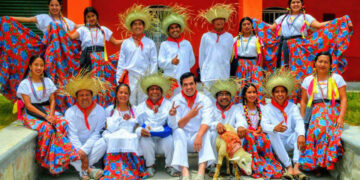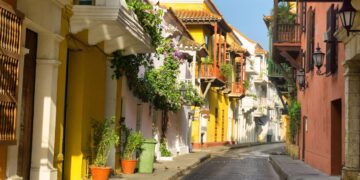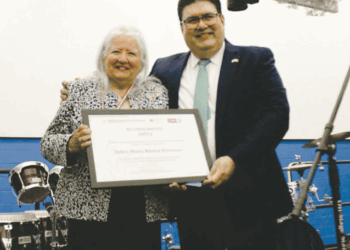The Nativity Scene is the most important element of Christmas, as it displays the representation of the scene in which Jesus Christ was born.
Year after year, the Vatican City displays this scene and this year 2024 Pope Francis I showed a baby Jesus being born on a Palestinian Kufiyah showing the clear solidarity of the Catholic Church towards the Palestinian Arab people, which, since October 8, 2023, has been incessantly massacred by the State of Israel, mainly in the territory of the Gaza Strip.

The scene of the birth of Jesus Christ usually has certain basic elements: Mary, Joseph, Jesus lying on straw and a couple of stable animals.
The scene shows Mary and Joseph in a barn because they had to wander the streets of the city of Bethlehem, 10 kilometers from the city of Jerusalem, looking for an inn where they would be given accommodation. Mary was about to give birth to Jesus the savior.
Mary and Joseph, being foreign migrants in hostile times, the people of Bethlehem were wary of receiving them in their homes. Until a very poor family with little to offer, allowed them to stay in their stable, hence the fact that at least one animal is usually added to the representation, such as a cow, a sheep, a goat or a donkey.

In some places like México a Perú, nativity scene contests are held, which include rules about the materials for their elaboration, the meters, some details that should not be left out in the narrative. Some people show the entire town in aspects that highlight the artisan culture. In Latin America, Latin issues and features are included in the figurines. In other places, they include more wintery elements such as houses with snow.
Since Latin America is a community of great artistic talent and expression, the elaboration of narratives with visual representations such as sculptural stories serve to preserve and give continuity to memory, in this case, religious stories.
In times like Christmas, it is necessary to remember the importance of human lives and especially of childhood as the future of humanity.
The Church of the Nativity is built where Jesus Christ was born in Bethlehem, Palestine. For many Catholics it is one of the most important religious sites, as is the visit to Vatican City.
The Palestinian Kufiyah, where Jesus rests in the Vatican Nativity, is the most important piece of clothing of Palestinian culture, containing the three most important symbols of their identity: the leaves of the olive tree, the weave of fishing nets that also represents brotherhood and fraternity among Palestinians, and the trade routes that pass through the land and navigable territory.

Since 1947, the Palestinian people have faced a series of violence inflicted against their people, first by the United Kingdom and later by State of Israel, founded by the Jews who were expelled from Europe after de World War II to be relocated in the Palestinian territory stealing and displacing Palestinians from their own houses. The genocide that Palestinians have been facing in the Gaza Strip has ended with hundred of tens of thousands of children, some of them, descendants of the very first Catholics from the world.
Escena del Nacimiento de Cristso y Pesebre
El nacimiento es el elemento más importante de la navidad, pues expone la representación de la escena en que nació Jesucristo.
Año tras año la Ciudad del Vaticano expone esta escena y este año 2024 el Papa Francisco I mostró un niño Jesús que nace sobre una Kufiya Palestina mostrando la clara solidaridad de la Iglesia Católica hacia el pueblo árabe palestino, el cual, desde el 8 de octubre del 2023 ha sido incesantemente masacrado por el Estado de Israel principalmente en el territorio de la Franja de Gaza.

La escena del nacimiento de Jesucristo, también llamado pesebre, suele tener ciertos elementos base: María, José, Jesús tendido sobre paja y un par de animales de establo.
A la escena se le considera el pesebre debido a que María y José tuvieron que deambular por las calles de la ciudad de Belén, 10 kilómetros de la ciudad de Jerusalén, buscando una posada dónde les dieran alojamiento. María se encontraba en a punto de dar a luz al Jesús el salvador.
María y José siendo migrantes extranjeros en tiempos hostiles, las personas sentían desconfianza de recibirlos dentro de sus casas. Hasta que una familia muy muy pobre y sin mucho qué ofrecer les permitieron quedarse en el establo, de ahí a que en la representación suela añadirse al menos un animal como una vaca, una oveja, una cabra y un burrito para carga.

En algunos lugares se hacen concursos de nacimientos, que incluyen reglas sobre los materiales para su elaboración, los metros, algunos detalles que no deben dejar de lado dentro de la narración. Algunos trazan el pueblo entero en aspectos que destacan la cultura artesanal. En Iberoamérica se incluyen cuestiones y rasgos latinos en las figurillas. En otros lugares, incluyen elementos más invernales como casas con nieve.
Siendo Iberoamérica una comunidad de gran expresión artística la elaboración de narrativas con representaciones visuales como son los relatos escultóricos que funcionan para preservar y dar continuidad a la memoria, en este caso, religiosa.
En épocas como la navidad es necesario recordar la importancia de la vida humana y sobre todo de las infancias como futuro de la humanidad.
La iglesia de la Natividad está construida donde nació Jesucristo en Belén, Palestina. Para muchos católicos es una de los lugares religiosos más importantes, como lo es la visita a la ciudad del vaticano.
La Kufiya Palestina, donde reposa Jesús en el nacimiento del vaticano, es la prenda más importante de la cultura Palestina, contiene los tres símbolos más importantes de su identidad: las hojas del árbol de olivo, el tejido de las redes de pesca que también representa la fraternidad y hermandad entre los palestinos, y las rutas comerciales que pasan por el territorio terrestre y navegables.

El pueblo palestino ha enfrentado desde 1947, principalmente, a una serie de violencia infligida contra de su pueblo, primero por parte del Reino Unido y posteriormente, por parte del Estado de Israel fundado por los judíos que fueron expulsados de Europa posterior a la Segunda Guerra Mundial para ser relocalizados en el territorio de la nación Palestina, robando y desplazando a miles de palestinos de sus propias casas. El genocidio que los palestinos están enfrentando en Gaza ha sido abiertamente denostado por el papa Francisco I.














































